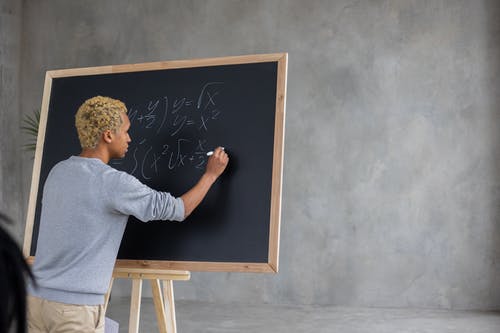|
Would You Rather Listen to the Lesson?
|
When students start with Algebra 2, solving equations is one of the first lessons they encounter. Typically, students learn to create equations and inequalities in one variable and use them to solve problems. This also includes simplifying algebraic expressions to solve equations and solving word problems by using one-variable equations.
If you’re wondering what strategies math teachers can adopt to facilitate this learning process – you’ve come to the right place! Today we’ll share a few math strategies that will help you teach solving equations like a pro!

What Is Solving Equations?
Explain to your math students that you’ll be solving equations in one variable and remind them that solving an equation refers to the process of providing a number that can be plugged in for the variable so that we end up with a true statement.
Provide an example of the type of equations you’ll be solving today, such as:
4(2x + 6) = 2(–4x – 10)
After this brief intro, proceed by explaining the different types of properties that you’ll be using to solve equations in one variable.
Types of Properties of Equality for Solving Equations
Reflexive Property
Explain that the reflexive property states that for any real number 𝑥, 𝑥 = 𝑥. In other words, a number equals itself, hence the name ‘reflexive property’. In addition, for any real numbers 𝑥 𝑎𝑛𝑑 𝑦, if 𝑥 = y, then y = 𝑥.
Transitive Property
Just like the reflexive property, the transitive property also denotes an equivalence relation. The transitive property states that two numbers that are equal to the same number are also equal to each other.
That is, for any real number x and y, if 𝑥 = y and y=z then x=z.
Addition Property
According to the addition property, for all real numbers x, y, and z, if 𝑥 = y, then 𝑥 + 𝑧 = y + z. That is to say, if we add the same number on both sides of the equation, we’ll end up with an equivalent equation.
Subtraction Property
The subtraction property of equality states that for all real numbers 𝑥, 𝑦 𝑎𝑛𝑑 𝑧, If 𝑥 = y, then 𝑥 − 𝑧 = y − z. In other words, if we subtract from one side of a given equation, we also have to subtract from the other side in order to balance the equation.
Multiplication Property
According to the multiplication property, if we multiply the two sides of a given equation by the same number, they stay equal. In other words, we can say that for all real numbers 𝑥, 𝑦 𝑎𝑛𝑑 𝑧, If 𝑥 = y, then 𝑥𝑧 = yz.
Substitution Property
The substitution property means that if 𝑥 = y, then x can replace y in any expression, just as y can replace x in any equation, for all real numbers 𝑥 and 𝑦. You can also provide an example, such as: “we can write x + 5 = 7 as y + 5 = 7”.
Distributive Property
The distributive property of equality states that multiplying a number by a sum, equals multiplying this number by each term in the sum. In other words, for all real numbers 𝑥, 𝑦 𝑎𝑛𝑑 𝑧, 𝑥(𝑦 + 𝑧) = xy + xz.
How to Solve Equations
Before diving into solving equations, you may also want to briefly review previous concepts and lessons, such as simplifying algebraic equations, or properties of real numbers. You can also check out this article on re-writing algebraic expressions in a simplified form, as well as this article on properties of real numbers.
After having gone through the properties of equalities, you can provide a few examples to demonstrate how students can apply these properties in practice while solving equations. A good resource to get you started is this video by Khan Academy.
The video contains step-by-step instructions on how to use the distributive property to simplify an equation such as: – 9 – (-9x – 6) = 3 (4x + 6). Pause it and put it on repeat as many times as needed until the kids understand the procedure. Provide examples of using the other properties, as well.
Afterward, you can move on to more complicated problems, such as interpreting word problems as equations. Use this video for that purpose, which contains simple guidelines for solving word problems through equations, such as transforming this word problem:
“The sum of four consecutive odd integers is 136. What are the four integers?”
into:
4x + 12 = 136

Algebra 2 – Solving Equations Activities
To practice solving equations with your students, you can use diverse games and activities. We’ve included two such activities in this article
Online Quiz
Use this online quiz at the end of your lesson on solving equations to review the learned concepts and practice. You can arrange students in pairs. Each student works on a separate device and tries to answer the questions from the quiz.
The game contains several math problems where children are asked to solve an equation with a variable on both sides, such as 10x – 5 = 21 – 3x. Multiple answers are provided so that children can choose from one of them.
After providing an answer for all questions, a score is given for the student doing the quiz. At this point, the two students in a given pair compare their final results. The student with the highest score wins the game.

Riddle Game
To play this game in the classroom, you’ll need to prepare several cards with word problems, depending on the number of students you have. The word problems should resemble riddles. An example of such word problems could be the following:
“Robert’s father is 4 times as old as Robert. After 5 years, the father will be three times as old as Robert. Find their present ages”
You can also use the word problems on page 2 of this Assignment Sheet (Members Only).
Divide students into groups of 3, 4 and make sure you’ve created a one-word problem card per group. Hand out the cards to the groups and explain to students that they will play a game where they’re supposed to unriddle the riddles on the cards with the help of one-variable equations.
The group that manages to solve their riddle first wins 1st place, the second one comes in second, etc.
Before You Leave…
We hope to have shown you that in Algebra 2, solving equations can be an engaging experience for your students! If you liked the above math strategies, you’ll love our lesson that’s dedicated to this topic!
So if you need guidance to structure your class and teach this, sign up for our membership MathTeacherCoach or head over to our blog – you’ll find plenty of awesome resources that are guaranteed to help you in your teaching!
And if you’d like to have a preview, sign up for our emails to receive our Algebra 2 freebies!
This article is based on:
Unit 1 – Tools of Algebra

